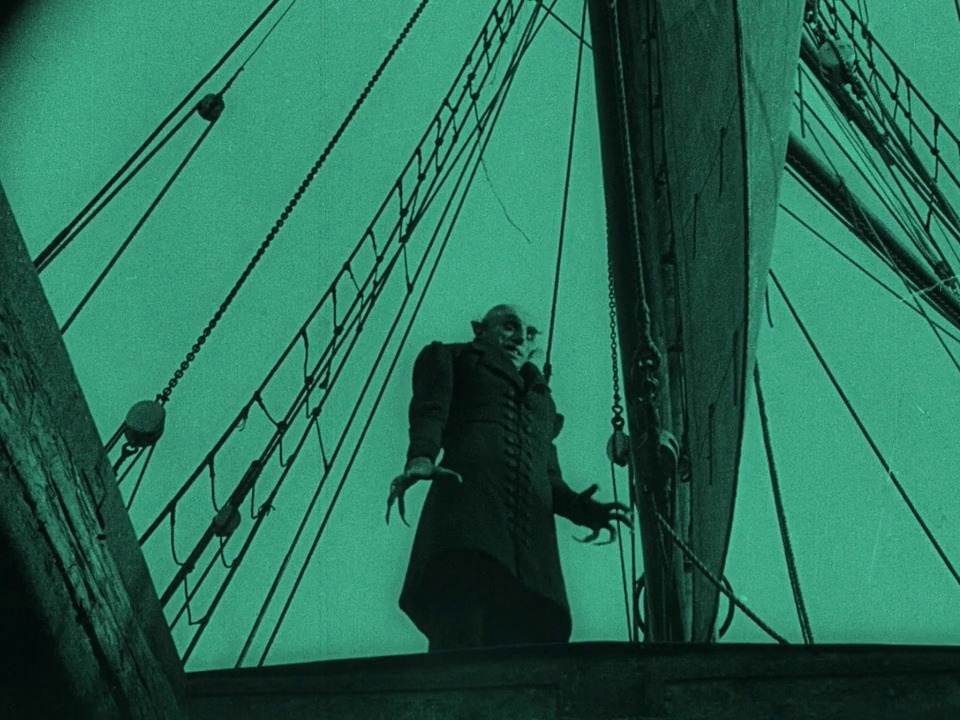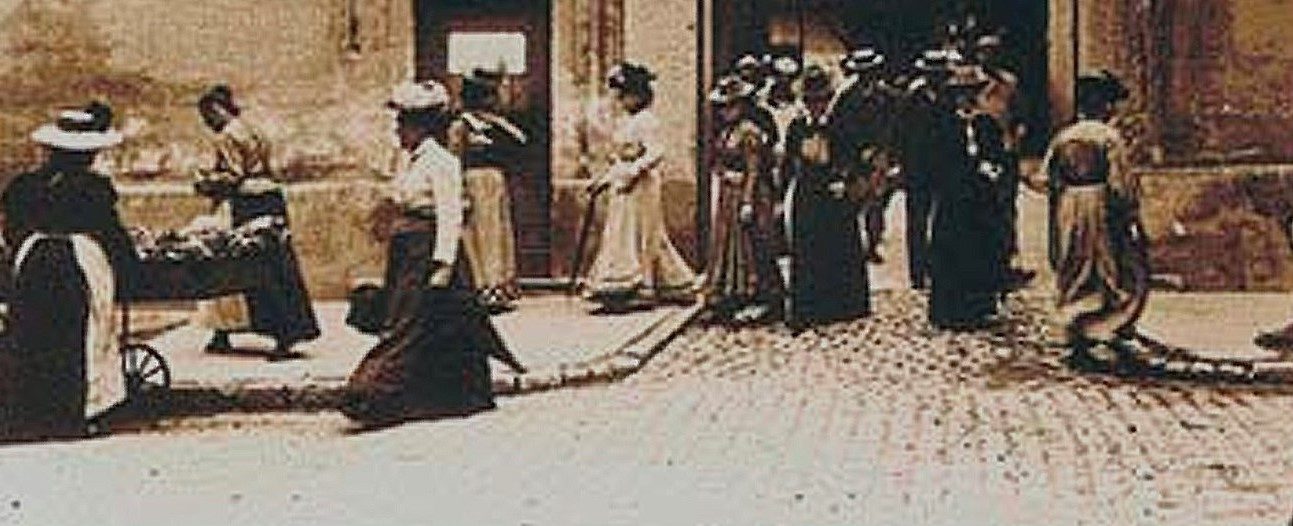Germany, 1922
Directed by Friedrich Wilhelm Murnau
With Gustav von Wangenheim (Thomas Hutter), Greta Schröder (Ellen Hutter), Max Schreck (Count Orlak), Alexander Granach (Knock), John Gottowt (Professor Bulwer)

Light is life while Death forever lurks in the shadow: this clear-cut opposition is nicely captured by the stark contrast of the images. The beginning of the first act is bathed in an exquisite bright light highlighting the happy faces of the happy couple made up of office worker Thomas Hutter and housewife Ellen Hutter as well as the charm of a garden or the playfulness of a young cat; the apparition of the Carpathians mountains later, towering and forbidding, gray and grim, signal the disturbing power of darkness. If Ellen could simply regret how wilted are the cut flowers Thomas has picked for her in the brightly-lit garden, a reminder that life is priceless, Thomas is compelled to grasp with shivering feelings as he enters a world where life has no point, trapped as it is by old and paralyzing fears, like a wandering werewolf or vampires.
Light and shades fighting over bodies: an essential feature of the new cinematic style called Expressionism to which also pertain the strange sets and the even strangest, truly creepy titular character whom Thomas is doomed to cope with. The word is borrowed from the art history but does convey something of the bold, mind-boggling and provocative worlds, made out of paper and wood, of two landmark movies of the new German school of cinema arising from the ashes of the First World War – “Das cabinet des Dr. Caligari – The Cabinet of Dr. Caligari” by Robert Wiene and “Von morgens bis mitternachts – From Morning to Midnight” by Karlheinz Martin, both shot in 1920 and imposing a distorted vision of the depressing human experience. What also defined those movies and others was not only a concern with existential angst and the human instincts but also an obvious taste for scary tales and horrific situations; in this kind of Expressionism an older current is flowing, the darkest elements of Romanticism, the unnerving, often eerie, sometimes frankly spooky characters and developments that are the stuff of some of the tales retrieved by Wilhelm and Jacob Grimm or contrived by E.T.A. Hoffmann, shaped by a morbid inspiration about non-organic and non-human elements. Now German filmmakers harness this dynamics of terror and horror to sustain their young art with new, stunning narratives and bold, sophisticated narrations.
In this case, the real horror is not really a bloody splash on the silver screen even as Count Orlak swiftly proves he is not just a truly bizarre and ugly man but the real stuff that books warned Thomas against as he was traveling. Images are far more subtle and disturbing. Orlak’s terrible powers are simply but effectively suggested by the shadows of his raised hands and small head against the wall around the bed of Thomas who is sleeping in that mysterious castle of the Carpathians. But if such a suggestive shot is already upsetting for the audience, what appalls Thomas and is truly the key moment of the tragedy is the moment Orlak spends observing a medallion portrait of Ellen. The remark written on an intertitle is stupidly anticlimactic, or an awkward attempt at irony – the point is not that Ellen has a lovely neck; the fact Thomas has if not fully realized then surmised with panic is that the beauty of Ellen has wowed the jaded aristocrat, giving him a greater desire to buy the property Thomas has been peddling on the order of his boss, and also a friend of the Count, Knock.
This vampire has feelings – and a female beauty is worth a lot of money and troubles to him. This is the story of a spell-bound monster wielding his evil power to fulfill a desire. And the decisive tragedy comes from the fact that Ellen is responsive to that unholy attraction. When the story moves back to the quaint German small town of Wisborg (an imaginary place), the frightening and shocking mutual attraction becomes every day more obvious and inevitable till the two bodies eventually met, in a graphic scene that exposes the grisly behaviors of Orlak as well as the abandon of Ellen – the sexual drive which is translated by the physical interplay of power and submission and is underpinning the narrative relationship is clearly felt. It is a remarkably ambiguous: the young woman is indeed a prey but the horror of giving up her body to the monster is instrumental to the process of getting rid of him (as he is so excited by the female body that he misses the moment when dawn comes and fresh daylight destroys him). Purity does prevail over impurity – the devilish and disgusting nature of Orlak’s love is a mistake he cannot survive but the trouble it stirs still resonates – and leaves Thomas mourning and crying in what is not a happy ending but a sober tale of good and evil starkly embodied by awesome characters, both a wonderful woman grappling with a poignant and heartbreaking fate and a truly astonishing, rightly haunting presence of Evil, that gaunt, stiffed, incredibly white-faced and dreadfully black-clothed ageless man legends, and the title, call Nosferatu (a character owing much to Irish novelist Bram Stoker, whose heirs forbade the producers to use his book).
That nefarious creature stands, in a remarkable, genuinely spectacular, and chilling development, as a truly pervasive, threatening, destructive embodiment of evil and death: the journey from the Carpathians to Wisborg is carefully chronicled and detailed and the film is literally the log book of the spread of terror. Nosferatu is associated with the black death, that is the plague, and magically presents many aspects that illustrate a rot destroying a community (indeed, the Nosferatu name is borrowed from an ancient Greek word literally meaning “the bringer of the plague”). From tainted ground filling coffin-like boxes to packs of rats swarming, to the vampire itself moving like a ghost, the scourge is multifarious and assails humans slowly but surely, first from a young mariner to the whole crew of a ship turned into a mysterious, untended vessel, and then from poor people suddenly dying in their houses to the sacrifice of Ellen.
Nosferatu is more than a vampire: he epitomizes horror and destruction always threatening the humans. The sequence featuring a scholar, and a friend of Thomas’, Professor Bulwer, explaining in the most scientific style (including images straight from a biology documentary) to an audience how nature is made up of dreadful little creatures bent on destroying each other is telling: humans may be unaware of it but nature has an unkind face, the charming garden coexisting with repugnant animals. Nosferatu is the enemy of mankind, lurking in the corner and ready to attack; he is the perversion of life; he is also a powerful presence shaping narratives (the books, the intertitles which are the reminiscences of a native of Wisborg, the arc of the story) and imaginations, embodying fears and threats of the oldest origins and the greatest importance. As captured by the camera of director Friedrich Wilhelm Murnau he gives the nascent cinematic Expressionism another dimension: such a film moves beyond the dramatic exploration of individual angst and madness in a troubled society to reach deep-rooted myths about life and death, good and evil, purity and rot, giving them a splendid, if disquieting, illustration.

